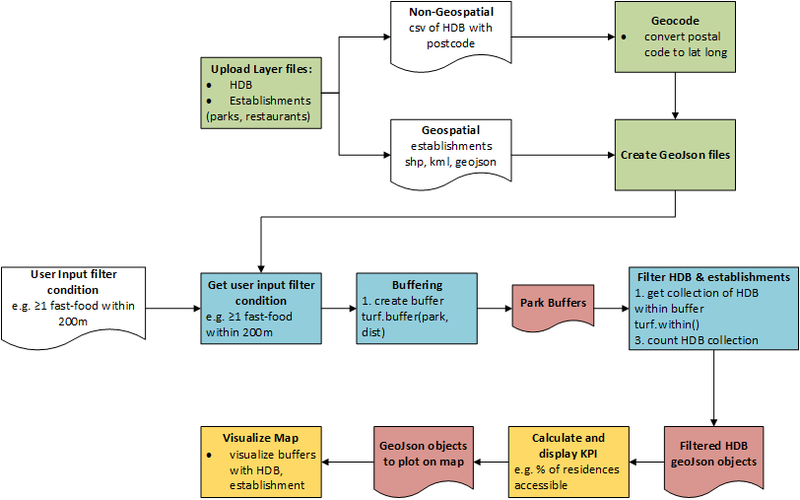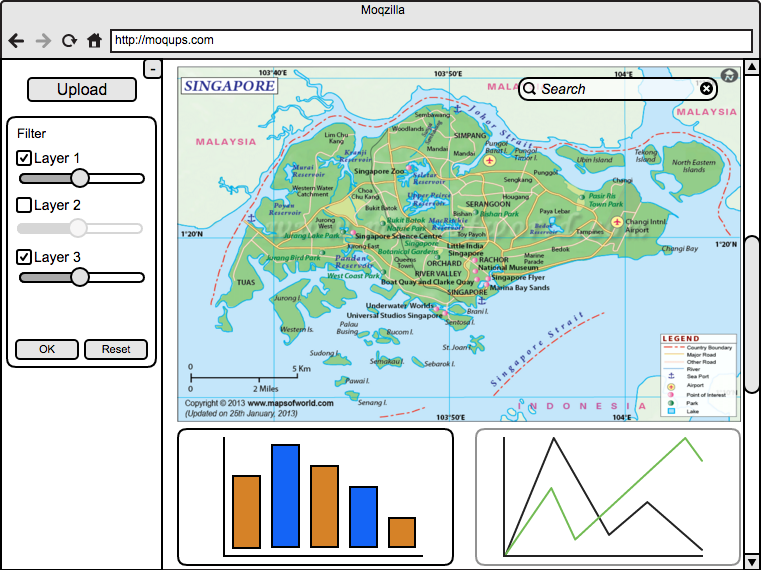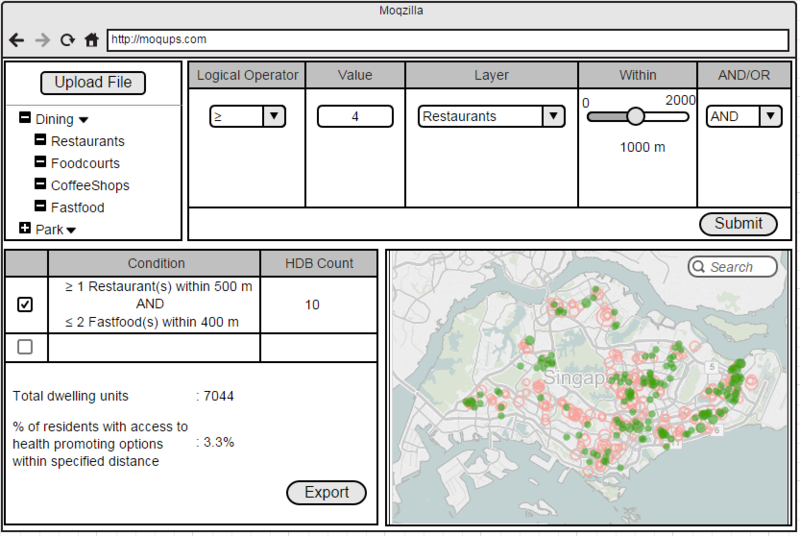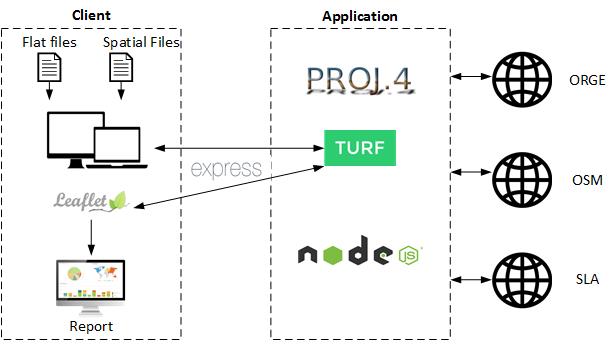Difference between revisions of "AY1516 T2 Team HealthTics Analysis"
Sanyein.2012 (talk | contribs) |
Sanyein.2012 (talk | contribs) |
||
| Line 44: | Line 44: | ||
=== CHANGES IN USER INTERFACE === | === CHANGES IN USER INTERFACE === | ||
| − | ===Version 1=== | + | ====Version 1==== |
[[File:Healthtics prototype 1.jpg|800px|center]] | [[File:Healthtics prototype 1.jpg|800px|center]] | ||
| Line 50: | Line 50: | ||
As shown above, the initial storyboard was designed to cater to the file upload and mapping function that were mentioned during a meeting with the sponsor. On the left hand side of the user interface, there are filters to select how many points to be shown on the map. The bottom of the page is reserved for displaying charts that are related to the analysis performed on the map. However, as there are more discussions with our project supervisor and project sponsor, this version of storyboard is not able to meet the client’s requirement. As such, our team designed the next version of the storyboard. | As shown above, the initial storyboard was designed to cater to the file upload and mapping function that were mentioned during a meeting with the sponsor. On the left hand side of the user interface, there are filters to select how many points to be shown on the map. The bottom of the page is reserved for displaying charts that are related to the analysis performed on the map. However, as there are more discussions with our project supervisor and project sponsor, this version of storyboard is not able to meet the client’s requirement. As such, our team designed the next version of the storyboard. | ||
| − | ===Version 1.1=== | + | ====Version 1.1==== |
After receiving feedbacks from both Prof Kam and our sponsor, we have revised on our mockup to improve functionality and feasibility. In this new mockup, HPB programme planners can upload files (both spatial and non-spatial) to add layers. Parent/child trees would satisfy the business requirement of categories and sub-categories. For example, fast-food chain is a sub-category of main category dining Planners can define criteria and choose "AND" "OR" situation of selected criteria. Toggle feature is added for better and less crowded visualization on the map so that planners can pick certain criteria to highlight on the map. | After receiving feedbacks from both Prof Kam and our sponsor, we have revised on our mockup to improve functionality and feasibility. In this new mockup, HPB programme planners can upload files (both spatial and non-spatial) to add layers. Parent/child trees would satisfy the business requirement of categories and sub-categories. For example, fast-food chain is a sub-category of main category dining Planners can define criteria and choose "AND" "OR" situation of selected criteria. Toggle feature is added for better and less crowded visualization on the map so that planners can pick certain criteria to highlight on the map. | ||
Revision as of 21:30, 28 February 2016
| MIDTERM PROGRESS | FINAL PROGRESS |
Contents
PROJECT UPDATE
REVIEW OF SIMILAR WORK
In the article “A Web-based browsing and spatial analysis system for regional natural resource analysis and mapping”, the authors have discussed that traditional GIS techniques and tools are lack of efficiency and easy to use delivery mechanism. For example, installation or hosting of GIS application and knowledge about geographic and GIS are required. Due to these constraints, many professionals outside GIS community have difficulties in applying GIS techniques in their practical uses. As such, more flexible and feasible web-based GIS applications are introduced.
The authors also explained about the earlier versions of server-centric web GIS applications which resulted in overloading the server. Because of performance issues as well as more flexible and advanced programming languages, client-side web GIS are now widely used by professionals in many fields. The flexible programming languages help create a customised environment for the end users so that knowledge about GIS techniques is no longer required in practical applications.
Moreover, the article gave an example of load-balanced web GIS application, WebSAS. WebSAS follows 3-tier architecture: client, application server and database. The architecture spreads out the work load in each tier and the database system provides image files so that the end user do not need understanding about geographic elements.
The key factors of web-based GIS application are efficiency and ease of use. Developers need to focus on load balancing for efficient data retrieval/access, apply proper GIS techniques, and understand end-user’s requirement from the application.
DATA FLOW
NOTE: Highlight the analytical problems we are facing and how we overcome with the data flow that we revised.
CHANGES IN USER INTERFACE
Version 1
As shown above, the initial storyboard was designed to cater to the file upload and mapping function that were mentioned during a meeting with the sponsor. On the left hand side of the user interface, there are filters to select how many points to be shown on the map. The bottom of the page is reserved for displaying charts that are related to the analysis performed on the map. However, as there are more discussions with our project supervisor and project sponsor, this version of storyboard is not able to meet the client’s requirement. As such, our team designed the next version of the storyboard.
Version 1.1
After receiving feedbacks from both Prof Kam and our sponsor, we have revised on our mockup to improve functionality and feasibility. In this new mockup, HPB programme planners can upload files (both spatial and non-spatial) to add layers. Parent/child trees would satisfy the business requirement of categories and sub-categories. For example, fast-food chain is a sub-category of main category dining Planners can define criteria and choose "AND" "OR" situation of selected criteria. Toggle feature is added for better and less crowded visualization on the map so that planners can pick certain criteria to highlight on the map.
DATA SOURCE
NOTE: Highlight how is it being used by the client in the application
METHODOLOGY AND TECHNOLOGY
NOTE: make sure to describe how these technologies will be used in the application. Highlight the analytical problems we are facing and how we overcome with the methodology and technology.
- GDAL
- OGR2OGR
- TURF.JS
- PAPAPARSE
SYSTEM ARCHITECTURE
Based on our research, efficiency of web GIS application largely depends on load balancing framework. To reduce overburdening the server and cost of investment in infrastructure for large servers, our group decides to use client centric web GIS with 2 tiers: Client and Application.
REVISED METHODOLOGIES
REFERENCES
StraitsTimes. (2014, May 7). One-quarter of workers report high stress levels. Retrieved from www.straitstimes.com/singapore/health/one-quarter-of-workers-report-high-stress-levels
OneMap. (n.d.). OneMap. Retrieved from http://onemap.sg
Singapore Land Authority. (2015, October 29). About OneMap. Retrieved from http://www.sla.gov.sg/e-Services/OneMap.aspx#.VpJjzcZ97IU
EnterpriseOne. (n.d.). BizMap. Retrieved from http://apps.enterpriseone.gov.sg/Bizmap/BizmapEnterpriseone.aspx
Nature Society of Singapore. (n.d.). Bird Watching Locations. Retrieved from http://www.nss.org.sg/wildbirdsingapore/Default.aspx
Public Utilities Board of Singapore. (n.d.). Managing Flash Floods. Retrieved from http://www.pub.gov.sg/managingflashfloods/WLS/Pages/WaterLevelSensors.aspx
Vatsavai, R. R., Burk, T. E., Wilson, B. T., & Shekhar, S. (2000). A Web-based browsing and spatial analysis system for regional natural resource analysis and mapping. Proceedings of the Eighth ACM International Symposium on Advances in Geographic Information Systems - GIS '00.



